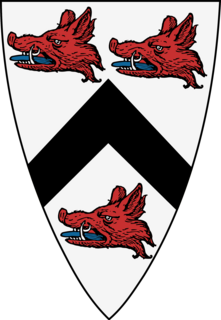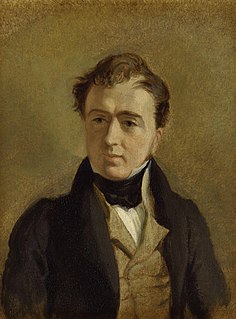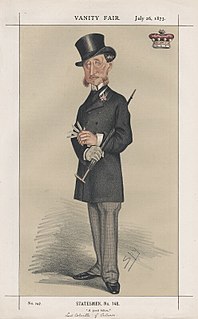
Earl of Carlisle is a title that has been created three times in the Peerage of England.

Marquess of Ely, of the County of Wexford, is a title in the Peerage of Ireland. It was created in 1800 for Charles Loftus, 1st Earl of Ely. He was born Charles Tottenham, the son of Sir John Tottenham, 1st Baronet, who had been created a baronet, of Tottenham Green in the County of Wexford, in the Baronetage of Ireland in 1780, by Elizabeth, daughter of Nicholas Loftus, 1st Viscount Loftus, sister and heiress of Henry Loftus, 1st Earl of Ely. In 1783 he succeeded to the Loftus estates on the death of his maternal uncle the Earl of Ely and assumed the same year by Royal licence the surname of Loftus in lieu of his patronymic. In 1785 he was raised to the Peerage of Ireland as Baron Loftus, of Loftus Hall in the County of Wexford. It was sold by the family in 1917 and is today owned by the Quigley family.

Marquess of Londonderry, of the County of Londonderry, is a title in the Peerage of Ireland.

Earl of Dunmore is a title in the Peerage of Scotland.

Earl of Macclesfield is a title that has been created twice. The first creation came in the Peerage of England in 1679 in favour of the soldier and politician Charles Gerard, 1st Baron Gerard. He had already been created Baron Gerard, of Brandon in the County of Suffolk, in 1645, and was made Viscount Brandon, of Brandon in the County of Suffolk, at the same time as he was given the earldom. These titles are also in the Peerage of England. Lord Macclesfield was the great-grandson of the distinguished judge Sir Gilbert Gerard, Master of the Rolls from 1581 to 1594. He was succeeded by his eldest son, the second Earl. He was involved in the Rye House Plot of 1683, was sentenced to death but later pardoned by the King. On his death without legitimate issue in 1701 the titles passed to his younger brother, the third Earl. He had earlier represented Yarmouth, Lancaster and Lancashire in the House of Commons. When he died in 1702 the titles became extinct.

Lord Kinloss is a title in the Peerage of Scotland. It was created in 1602 for Edward Bruce, later Master of the Rolls, with remainder to his heirs and assigns whatsoever. In 1604 he was also made Lord Bruce of Kinloss, with remainder to his heirs male, and in 1608 Lord Bruce of Kinloss, with remainder to any of his heirs. He was succeeded by his son, the second Lord, who was killed in a duel in 1613.

Lord Elibank, of Ettrick Forest in the County of Selkirk, is a title in the Peerage of Scotland. It was created in 1643 for Sir Patrick Murray, 1st Baronet, with remainder to his heirs male whatsoever. He had already been created a Baronet, of Elibank, in the Baronetage of Nova Scotia in 1628. His great-great-grandson, the fifth Lord, was an author and economist. He was succeeded by his younger brother, the sixth Lord, who was an admiral in the Royal Navy. On his death the titles passed to his nephew, the seventh Lord. He represented Peeblesshire in the House of Commons and also served as Lord Lieutenant of Peeblesshire.

Lord Elphinstone is a title in the Peerage of Scotland created by King James IV in 1510.

Earl of Lisburne is a title in the Peerage of Ireland. It was created in 1776 for Wilmot Vaughan, 4th Viscount Lisburne. He represented Cardiganshire and Berwick-upon-Tweed in the House of Commons and held minor governmental office.

Viscount Powerscourt is a title that has been created three times in the Peerage of Ireland, each time for members of the Wingfield family. It was created first in 1618 for the Chief Governor of Ireland, Richard Wingfield. However, this creation became extinct on his death in 1634. It was created a second time in 1665 for Folliott Wingfield. He was the great-great-grandson of George Wingfield, uncle of the first Viscount of the 1618 creation. However, the 1665 creation also became extinct on the death of its first holder in 1717.

Baron Manners, of Foston in the County of Lincoln, is a title in the Peerage of the United Kingdom. It was created in 1807 for the lawyer and politician Sir Thomas Manners-Sutton. He served as Solicitor-General from 1802 to 1805 and as Lord Chancellor of Ireland from 1807 to 1827. Manners-Sutton was the fifth son of Lord George Manners-Sutton, third son of John Manners, 3rd Duke of Rutland. His elder brother Charles Manners-Sutton was Archbishop of Canterbury from 1805 to 1828 and the father of Charles Manners-Sutton, 1st Viscount Canterbury, Speaker of the House of Commons from 1817 to 1834. The first Baron's great-grandson, the fourth Baron, assumed the surname of Manners only. As of 2010 the title is held by the latter's grandson, the sixth Baron, who succeeded his father in 2008.

Baron Churchill, of Wychwood in the County of Oxford, is a title in the Peerage of the United Kingdom and held by a branch of the Spencer family. It was created in 1815 for Lord Francis Spencer, younger son of the 4th Duke of Marlborough. He had previously represented Oxfordshire in Parliament.

Baron Ellenborough, of Ellenborough in the County of Cumberland, is a title in the Peerage of the United Kingdom. It was created on 19 April 1802 for the lawyer, judge and politician Sir Edward Law, Lord Chief Justice of the King's Bench from 1802 to 1818. His son, the second Baron, notably served as Governor-General of India. On 22 October 1844 the second Baron was created Viscount Southam, of Southam in the County of Gloucester, and Earl of Ellenborough, in the County of Cumberland. These titles were also in the Peerage of the United Kingdom. His only son predeceased him and on his death in 1871 the viscountcy and earldom became extinct.

Baron Northbrook, of Stratton in the County of Southampton, is a title in the Peerage of the United Kingdom. It was created in 1866 for the Liberal politician and former Chancellor of the Exchequer, Sir Francis Baring, 3rd Baronet. The holders of the barony represent the genealogically senior branch of the prominent Baring family. The name Northbrook is derived from a tithing of the local parish.
Baron Vivian, of Glynn and of Truro in the County of Cornwall, is a title in the Peerage of the United Kingdom and held by a branch of the Vivian family. It was created on 19 August 1841 for the soldier Sir Hussey Vivian, 1st Baronet. He had already been created a baronet, of Truro in the County of Cornwall, on 19 January 1828. His eldest legitimate son, the second Baron, represented Bodmin in the House of Commons and served as Lord Lieutenant of Cornwall. His son, the third Baron, served as British Ambassador to Italy from 1891 to 1893. The latter's great-grandson, the sixth Baron, was a soldier and a Conservative member of the House of Lords. Lord Vivian was one of the ninety elected hereditary peers that were allowed to remain in the House of Lords after the passing of the House of Lords Act 1999. As of 2014 the titles are held by his only son, the seventh Baron, who succeeded in 2004.

Baron Methuen, of Corsham in the County of Wiltshire, is a title in the Peerage of the United Kingdom. It was created in 1838 for the former Member of Parliament for Wiltshire and Wiltshire North, Paul Methuen. His grandson, the third Baron, was a distinguished soldier who became Field marshal. His son, the fourth Baron, was a professional artist and Royal Academician. On his death, the title passed to his younger brother, the fifth Baron. The seventh Baron, who succeeded his elder brother in 1994, was one of the ninety hereditary peers elected to the House of Lords after the passage of the House of Lords Act 1999, and sat on the Liberal Democrat benches. As of 2014, the title is held by his first cousin once removed, the eighth baron, who succeeded to the title in that year.

Robert John Carrington, 2nd Baron Carrington,, was a politician and a baron in the Peerage of Great Britain. He was the son of Robert Smith, 1st Baron Carrington, and Anne Boldero-Barnard. He adopted the name "Carrington" in 1839.

Charles John Colville, 1st Viscount Colville of Culross,, known as The Lord Colville of Culross between 1849 and 1902, was a British nobleman, Conservative politician and courtier.

Clan Colville is a Lowland Scottish clan.

Earl of Arran is a title in the Peerage of Ireland. It is not to be confused with the title Earl of Arran in the Peerage of Scotland. The two titles refer to different places: the Aran Islands in Ireland, and the Isle of Arran in Scotland. The Irish earldom is held by the Gore family. The Scottish earldom is a separate title, held as a subsidiary title of the Duke of Hamilton.
















